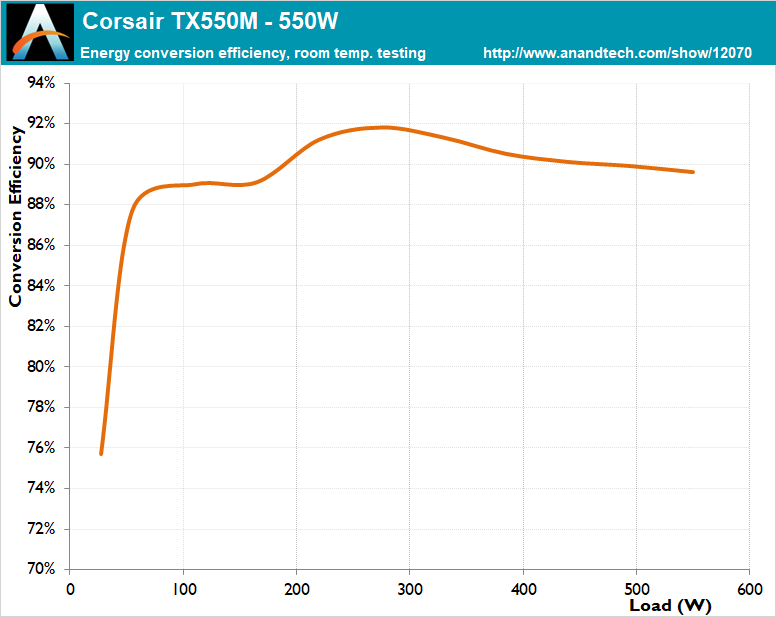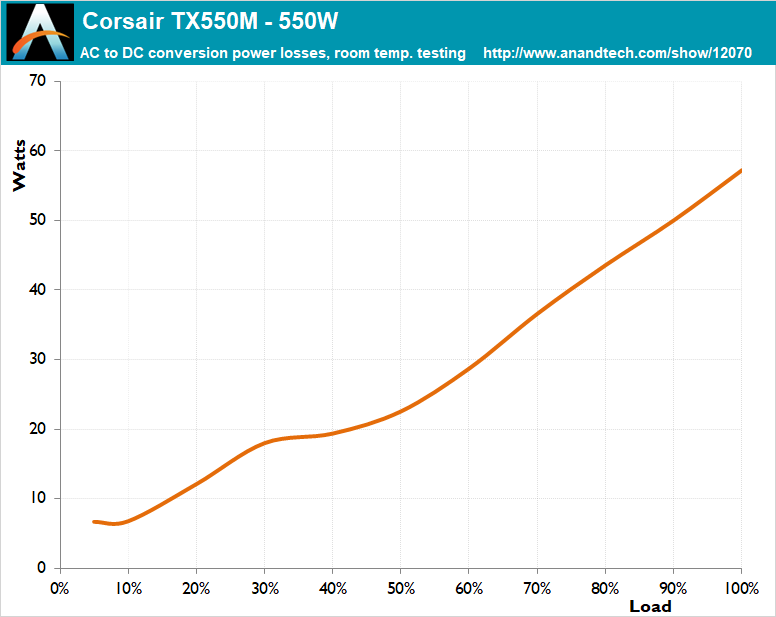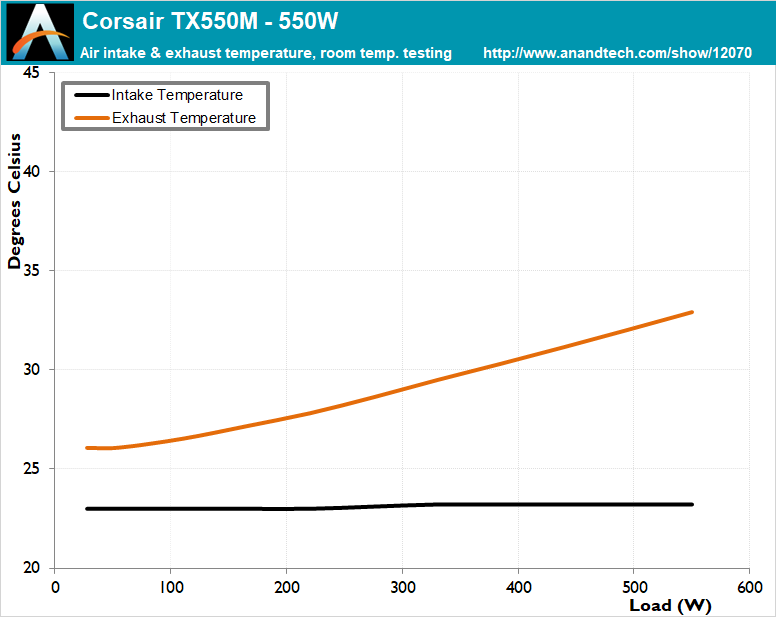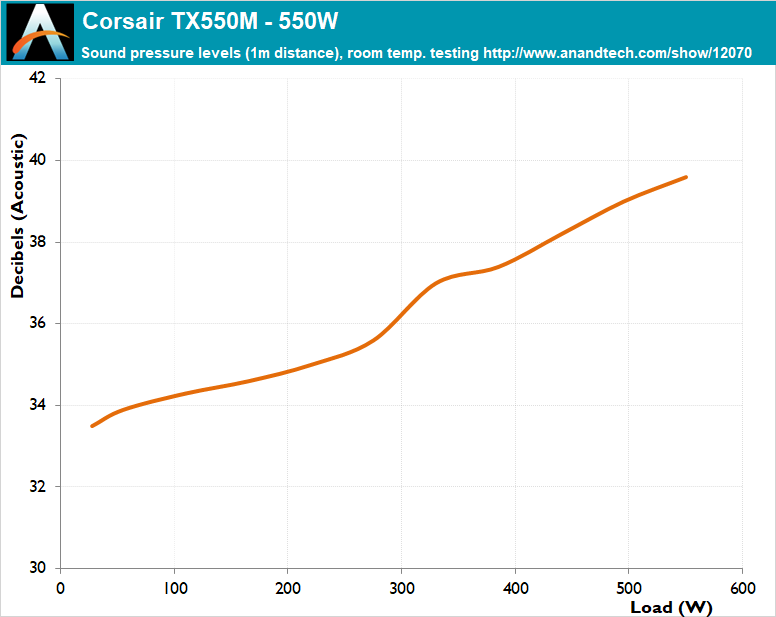The $80 Power Supply for Almost Everyone: The Corsair TX550M 80Plus Gold PSU Review
by E. Fylladitakis on December 1, 2017 8:00 AM EST- Posted in
- Cases/Cooling/PSUs
- Corsair
- PSUs
- 550W
- TX
- Modular
- Power Supply
Cold Test Results
For the testing of PSUs, we are using high precision electronic loads with a maximum power draw of 2700 Watts, a Rigol DS5042M 40 MHz oscilloscope, an Extech 380803 power analyzer, two high precision UNI-T UT-325 digital thermometers, an Extech HD600 SPL meter, a self-designed hotbox and various other bits and parts. For a thorough explanation of our testing methodology and more details on our equipment, please refer to our How We Test PSUs - 2014 Pipeline post.
The latest revision of the TX-M series is certainly improved in terms of efficiency, yet it still fails to achieve >92% at half load with an input voltage of 230 VAC. This result, however, does not mean that the unit’s certifications are false, just that it received its efficiency rating with an input voltage of 110 VAC, under which the 80Plus directive is slightly more lenient.
This particular model’s efficiency certification can be viewed here. The vast majority of manufacturers submit their units for 110 VAC testing - only 5% of the 80Plus certified non-redundant PSUs have been tested with an input voltage of 230 VAC. The TX550 maintains a good average efficiency of 90.3% within its nominal load range (20% to 100% of the unit's capacity) but tends to favor medium-to-heavy loads, struggling when the load is lower than 200 Watts.
The thermal control scheme of the Corsair TX550M is very simplistic, with the fan adjusting its speed according to the internal temperature of the unit. As such, it manages to maintain very low noise levels while at room temperature and up to medium loads. At heavier loads, the fan will increase its speed, yet not overly so, maintaining audible but typically comfortable noise levels.















42 Comments
View All Comments
Yuriman - Friday, December 1, 2017 - link
I'd argue that most home PCs without discrete graphics card are more in the 125-175w range, and many of those with lower end discrete cards (e.g. 1050 Ti) are still coming in under 200w, yet it's rare to find any company offering power supplies that cater to this market. Maybe the casual-use desktop is dead in the ATX form factor? Is everyone using NUC / micro PC / laptops instead?Yuriman - Friday, December 1, 2017 - link
I can't imagine power supplies being particular efficient in machines which idle at 5% of their total capacity, and torture test at less than 40%.A5 - Friday, December 1, 2017 - link
To answer your last question - yeah, the casual-use desktop is basically dead for home users. The big OEMs all still make some for businesses and the few people who want them, but they also right-size the PSUs on custom-order.Jhlot - Friday, December 1, 2017 - link
Exactly I am a light gamer (1050 Ti class) at this age and with time constraint of having young kids. I want a gold rated modular 300w supply at a reasonable price. They don't exist.leetcrew - Friday, December 1, 2017 - link
why even care about the efficiency rating on such a low draw machine? the difference between base 80plus and 80plus gold is 10% efficiency at 50% capacity. this is a delta of ~20W at load. if you live in the US, you would have to play for ~400 hours before you paid another dollar on your electric bill.t.s - Saturday, December 2, 2017 - link
Well, he is not like you sir. And I glad we still have someone like that around.DanD85 - Friday, December 1, 2017 - link
Because the maximum efficiency of a psu can only be reached when it runs at 50% load.Yuriman - Friday, December 1, 2017 - link
A 65w CPU + 75w video card + system components would be just over 50% load for a 300w unit when loaded. Case in point, my 5 year old Core i5 system with 1050 Ti draws between 150 and 175w while gaming.StevoLincolnite - Saturday, December 2, 2017 - link
Don't forget that Ram, Motherboard, Hard/Optical drives, USB devices and so on all consume power as well.t.s - Saturday, December 2, 2017 - link
Don't forget that Ram, Motherboard, Hard/Optical drives, USB devices and so on all consume < 30 watt.